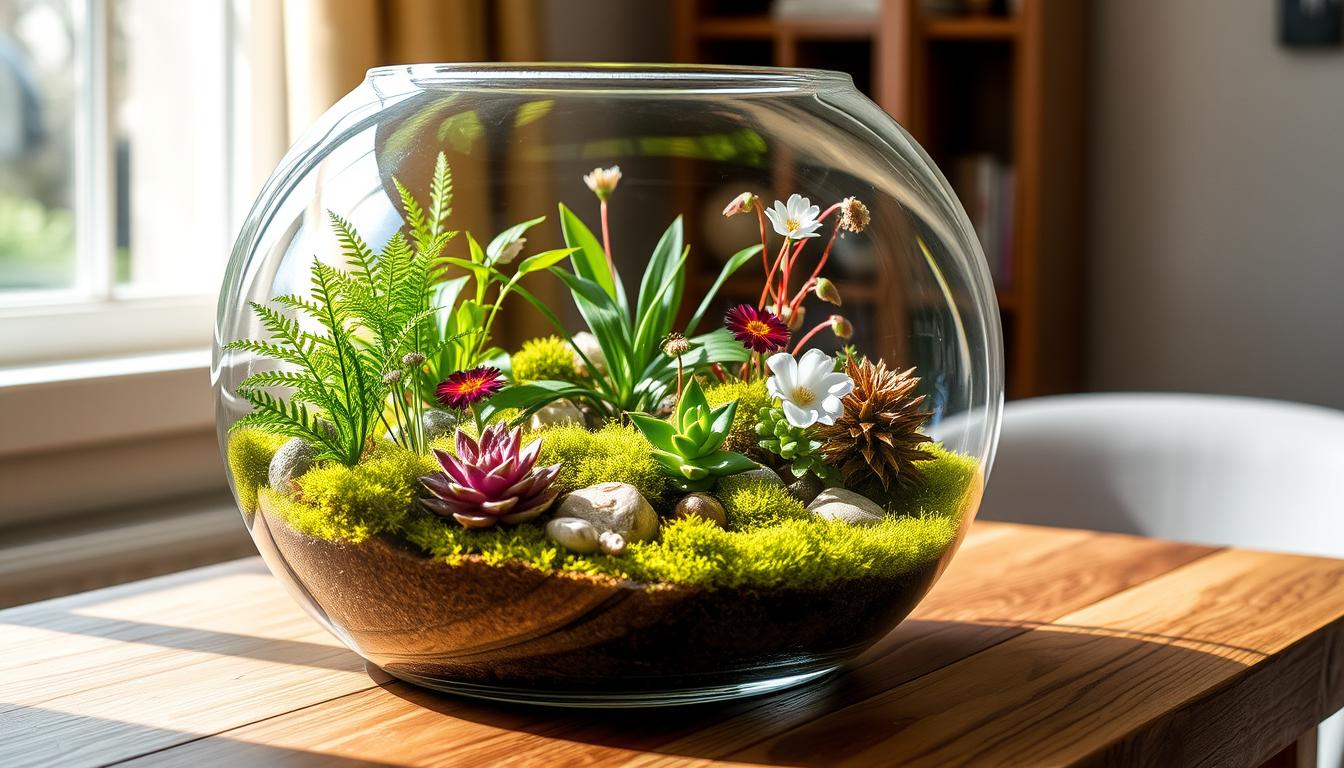Terrariums: A Miniature World at Your Fingertips

Have you ever wondered how to create a lush, thriving ecosystem inside a glass jar?
Terrariums are captivating miniature gardens that bring nature indoors. Whether you’re a seasoned plant lover or a beginner with a brown thumb, a terrarium offers a low-maintenance and creative way to connect with greenery. This article will guide you through everything you need to know about terrariums, from their history and benefits to creating and maintaining one yourself.
Key Takeaways
- Terrariums are self-contained ecosystems ideal for home or office spaces.
- They come in two types: open (dry plants) and closed (humid plants).
- Building a terrarium requires the right materials, plants, and care.
- They’re easy to maintain and perfect for beginners or advanced hobbyists.
Unexpected Fact
Did you know that the first terrarium was accidentally created in 1829 by Dr. Nathaniel Ward? He left a jar with soil and a fern sealed for weeks, leading to a thriving plant inside—a discovery that revolutionized gardening!
What is a Terrarium?
A terrarium is a glass container filled with plants and other natural elements to simulate a small ecosystem. These decorative pieces can either be open, ideal for cacti and succulents, or closed, creating a humid environment for ferns and mosses.
Terrariums serve both aesthetic and practical purposes, offering an accessible way to enjoy gardening indoors without needing outdoor space.
Why Are Terrariums So Popular?
Terrariums aren’t just pretty—they’re practical, too. Here’s why they’ve become a household favorite:
Benefits
- Space-Saving: Perfect for small apartments or offices.
- Low-Maintenance: Minimal watering needed due to their self-contained nature.
- Air Purification: Plants improve indoor air quality.
- Therapeutic: Gardening in miniature can reduce stress.
- Customizable: Build a terrarium to match your personal style.
Drawbacks
- Limited Plant Choices: Not all plants thrive in terrariums.
- Potential for Overwatering: Excess moisture can lead to mold.
- Fragility: Glass containers are prone to breaking.
Types of Terrariums
| Terrarium Type | Best Plants | Ideal Environment |
|---|---|---|
| Open Terrarium | Cacti, succulents | Dry, well-ventilated |
| Closed Terrarium | Mosses, ferns | Humid, low light |
| Hanging Terrarium | Air plants (Tillandsia) | Light and airy with minimal soil |
Tip: Always match the plant type to the terrarium environment for optimal growth.
How to Create a Terrarium
Building a terrarium is an easy and rewarding process. Follow these steps:
1. Choose Your Container
- Use a clear glass container like a jar, bowl, or even a lightbulb.
- Ensure the container is clean and dry before starting.
2. Gather Supplies
You’ll need:
- Pebbles or gravel for drainage.
- Activated charcoal to prevent odors.
- Soil suitable for your plants.
- Decorative elements like stones, moss, or figurines.
3. Layer the Base
- Add pebbles for drainage.
- Sprinkle a thin layer of charcoal to filter water.
- Add soil, ensuring it’s deep enough for plant roots.
4. Plant Selection
Choose small plants with similar light and moisture requirements. Examples:
- Succulents for open terrariums.
- Ferns and mosses for closed terrariums.
5. Decorate
- Add decorative stones, figurines, or moss for a personalized touch.
6. Maintenance
- Place your terrarium in indirect sunlight.
- Water sparingly based on the plant type.
Embedded Video: DIY Terrarium Guide
Watch this video to see the steps in action:
Tips for Terrarium Maintenance
- Monitor Moisture Levels
- Closed terrariums should have slight condensation in the mornings.
- Open terrariums need occasional watering based on soil dryness.
- Prune Regularly
- Trim overgrown plants to prevent crowding.
- Clean the Glass
- Wipe the inside of the glass to maintain visibility and reduce algae growth.
- Avoid Direct Sunlight
- Too much sunlight can overheat the terrarium.
Common Mistakes to Avoid
- Overwatering: Always err on the side of caution with water.
- Mixing Plant Types: Use plants with similar care needs.
- Poor Drainage: Without a proper drainage layer, roots may rot.
Creative Terrarium Ideas
Theme Terrariums
- Beach-Inspired: Add sand, seashells, and air plants.
- Forest Scene: Use moss, ferns, and miniature animals.
Unusual Containers
- Use teapots, wine bottles, or even old lightbulbs for unique designs.
Layered Sand Terrariums
- Create colorful patterns with layers of sand.
FAQs About Terrariums
Q: Can I use artificial plants in a terrarium?
A: Yes! Artificial plants are perfect for a maintenance-free option.
Q: Do I need to fertilize my terrarium plants?
A: In most cases, fertilization isn’t necessary due to the small ecosystem.
Q: How long do terrariums last?
A: With proper care, terrariums can last for years.
Q: Can I include animals in a terrarium?
A: Small creatures like snails or insects can thrive in a closed terrarium but require extra care.
Table: Terrarium Do’s and Don’ts
| Do’s | Don’ts |
|---|---|
| Choose suitable plants | Overwater your terrarium |
| Use clean containers | Place in direct sunlight |
| Monitor humidity | Mix incompatible plants |
Embedded Video: Advanced Terrarium Tips
For advanced techniques, watch this video:
Pros and Cons of Terrariums
Pros
- Compact and Versatile: Fits any space and décor style.
- Educational: Great for kids to learn about ecosystems.
- Affordable: Can be made with simple, low-cost materials.
Cons
- Fragile: Glass containers require careful handling.
- Limited Plant Selection: Some plants outgrow terrariums.
- Humidity Issues: Excess moisture can lead to mold growth.
Conclusion: Your Green Oasis Awaits
Terrariums are more than just decorative pieces—they’re tiny ecosystems that bring joy, creativity, and a touch of nature into your home. Whether you’re designing a whimsical forest scene or a sleek modern centerpiece, the possibilities are endless.
So, grab a glass jar, let your imagination run wild, and create a terrarium that speaks to your style and love for greenery. It’s time to bring the outdoors in!



